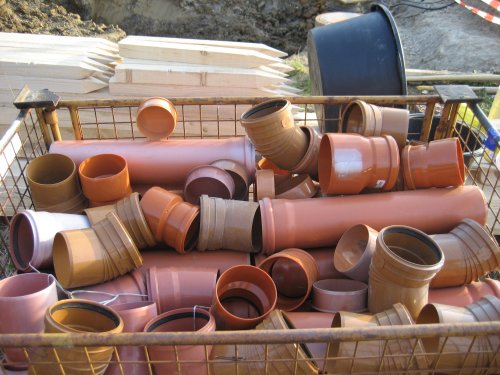 No Tees
No TeesHere is a picture of the plumbing parts sent to us. After a few planning problems arose from a error made by the surveyor it looks like we can start but where are the tees?
This brings us to an important part of your building process. Set up your accounts with the local building suppliers before you get started so you can pick up missing things without waiting for deliveries. It is not always possible to remember or plan for all possibilities that might occur at your building site. So far Jogi has been flexible enough that when we are missing things they are quickly shipped to us or we are allowed to pick them up ourselves and Ytong will pay the bill. This is not an ideal situation for either you or Ytong so look over your deliveries as soon as they come and try to foresee any future shortcomings early.
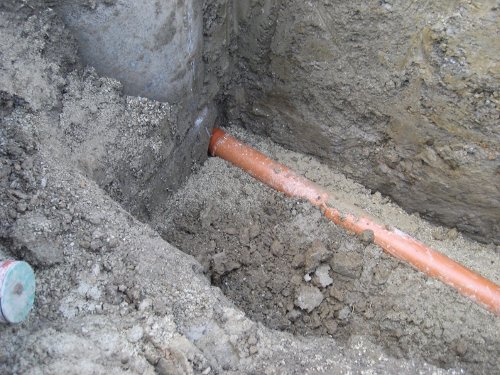 No 150mm Pipes
No 150mm PipesWell it was off to the building supply for the first pipes. The sewage from your house will be connected close to the road at a control point. The connection should be made if the height is suitable at the supplied entrance point. The appropriate pipe size is 150cms and this size of pipe should be continued until close to your house. The fall should be between 1 and 2%.
July 27, 2009
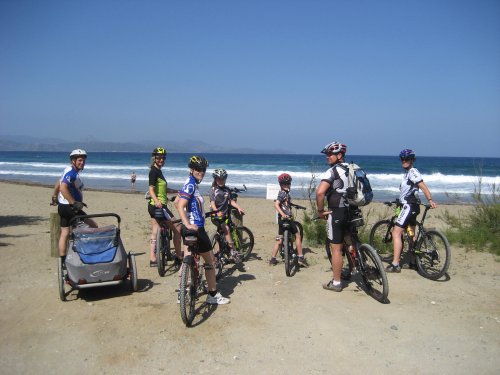 Delays for Plumbing instructions and materials to start
Delays for Plumbing instructions and materials to startOn this date I was told by Aktiv Bausatzhaus on July 30 I would be given my instructions as to the plumbing work and materials for our house. On July 31 we received an Email that hopefully we might be able to start the following week as the planning would be finished on August 3.
Delays did not happen often but once in a while. If you can leave a few of the none important things for rain days or shortages of materials days this may be a benefit. You may want to give Aktiv Bausatzhaus Südbaden GmbH notice of any holiday plans you have so that they can keep up. Here we are seen in Corsica for 2 weeks at the end of June. This holiday was a reward for a good project start.
Shortly after Heima Installs Heating System
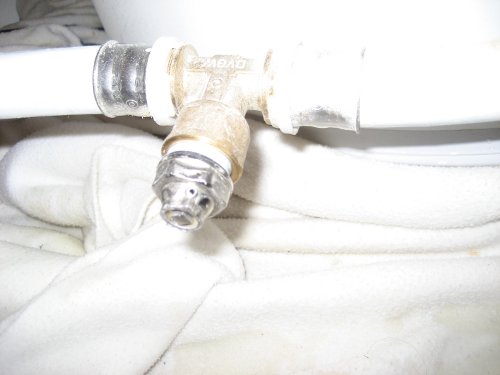 First Impressions
First ImpressionsSometimes first impressions are correct. This is how we started. The company Heima had finished installing the heating system or at least making it operational. They left the connections for hot and cold water for us to complete. We received in our package also a circulating pump for hot water. The technical advisor from Aktiv brought materials and tools to complete the installation. This was one of the few or perhaps only time he actively helped with the building of our house.
In the picture is the connection for draining our hot water tank. This is a manual air relief valve. In case you are wondering draining our hot water tank with this valve would take several hours if not a day. Yes I started to worry. For over an hour I cut pieces of pipe and he connected our water and circulation pump. As we finished I questioned about the settings for the heat pump system. He honestly answered that he had little knowledge of the system and hoped some day he would be trained.That evening I studied the manual while sitting next to the heat system.
Between reading I slowly looked at what we had installed. Yes, our hot and cold water was complete but the circulating pump had no possible way to correctly function. The tools and more fittings were returned to me promptly so I could correct the plumbing. Some of the following pictures show some of the things we learnt through our own and other means.
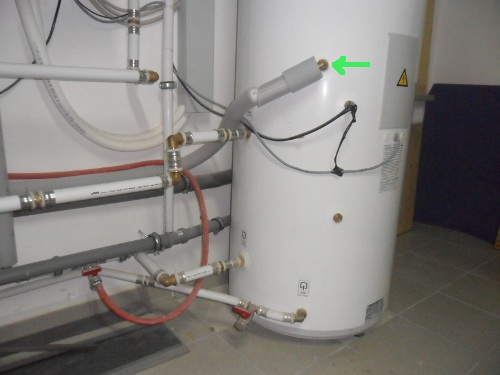 Connections to Hot Water Tank
Connections to Hot Water TankSome would connect a circulating pump to the cold water inlet at the very bottom of the tank. This is not correct. The tanks are designed with areas that may contain water of different temperatures. Circulating pump water should enter the tank at the position shown by the green arrow. This is the connection that Daikin provides and recommends.
Notice that we have started to insulate our piping. You can find insulating products in your local building supply store. I am not sure if Aktiv will supply this type of insulation for the open areas of your piping in the heating room of your house. For your hot water circulating system heat loss accounts for at least 80% of the costs, from the literature I have read, but more on that later. Also notice that Aktiv has now supplied a proper drain valve.
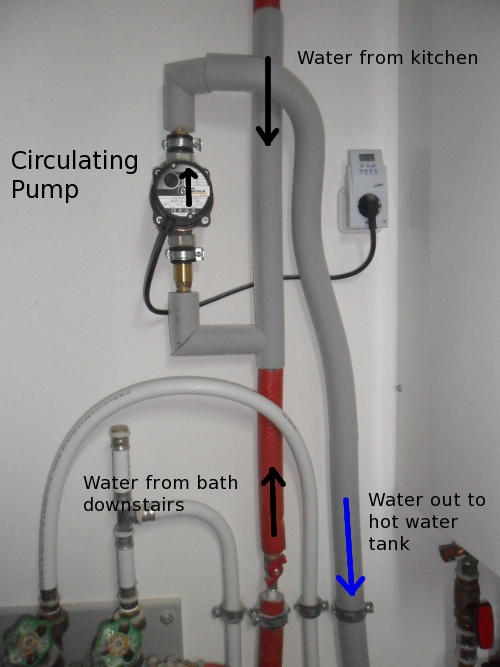 Connections for Circulating Pump
Connections for Circulating PumpYour circulating pump normally draws water from one furthest locations in your hot water plumbing. This keeps the water hot in the piping so that when you turn on a tap the water is hot very quickly. Since we have a often used bathroom in the basement and also two on our second floor I have done something unusual.
In the picture you can see that water comes to the pump from both our kitchen and our bathroom downstairs. More on why the kitchen in the next picture. Directly underneath the black arrow showing the water from the downstairs bathroom is a shutoff valve. This valve is very important. The idea here is that the line to the downstairs bath is much shorter than the line/piping coming from the kitchen. This much shorter line will become warm much faster than the longer line. In order to operate efficiently this valve will be closed to the point that when the circulating pump operates the water from both directions will become warm at the same time. By trail and error you can set this valve after letting the system cool and then restart the pump.
The timer which the pump is plugged into is a high quality/feature timer that Aktiv supplied us with. There are however many other options which I will explain later.
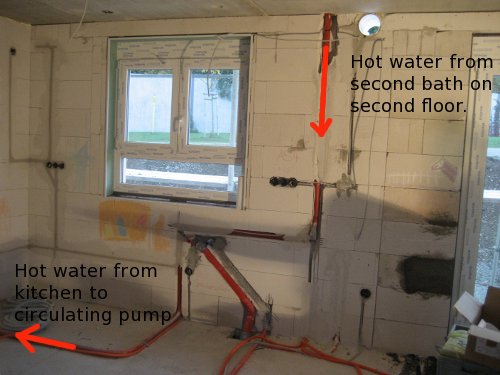 Routing hot water in house
Routing hot water in houseWhy kitchen water? Well the main supply line for hot water leaves the tank in the basement and heads for the last bathroom upstairs. Along the way connections take the water to various other locations. Since we like the comfort of having warm water quickly at most taps I took the time to take the main supply line through the important rooms and then onto the next instead of splitting the main line in different directions. The hot water flows through the first upstairs bath and then onto the second. Since the second is directly above the kitchen the piping then comes down to the kitchen. From here a line returns it to the circulating pump that pumps it into the hot water tank thus completing the circulation of hot water.
A word of caution. If you connect your water in such a fashion and chose to not use a circulation pump the connections I have made will cause a longer wait for hot water in your kitchen. Connecting the 16mm line returning from the kitchen to the circulating pump to your main hot water supply line would, in the case of not using a circulating pump, greatly improve this situation. This is called looped supply and can help in special situations.
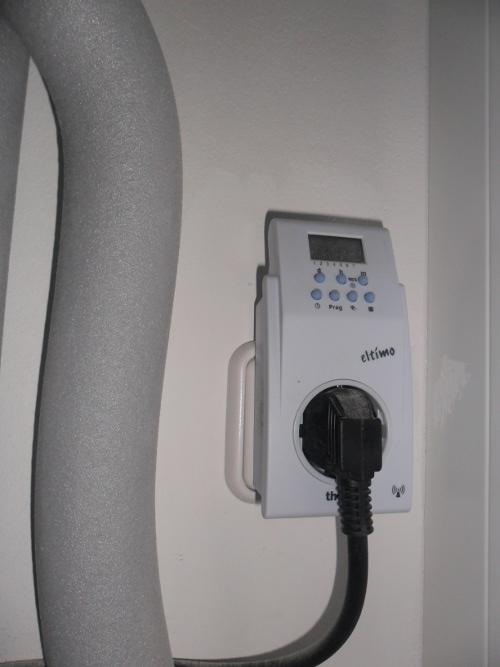 Circulate or Not?
Circulate or Not?Jogi has told me that Aktiv no longer includes circulating pumps as a feature in their houses? They think you will save money without having a circulating pump running and losing heat energy in your house.
There are two running costs involved. The electricity to power the pump and the loss of heat energy. From what I have read 80% or so goes to the loss of heat energy. Where is the heat energy lost? In your house. If your heat system is running then you have no or little loss as this energy helps to heat your house. I have said, "no or little loss" because a Daikin heat pump will sense the fall of temperature in the hot water tank. If this fall is slow the system may use it's electric heating element more often to top off the water temperature. Without making a involved study of the Daikin controller and the various efficiencies I would guess that the added costs are minimal.
Our pump uses less than 30 watts when it runs. This is less than half of the power needed to run a standard light bulb. In my opinion the costs are small for the comfort of having warm water ready at your taps.
If you want to reduce the costs there are many methods to control the circulating pump to reduce the running time. The timer shown here was supplied by Aktiv Bausatzhaus Südbaden GmbH. It is one of the best timers on the market but still does not provide optimal control of the circulating pump.
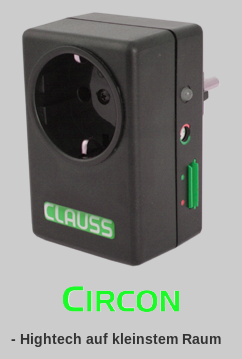 Circon Circulating Pump Controller
Circon Circulating Pump ControllerIn order to keep our hot water hot throughout the day our pump should turn on for 5 minutes every half hour. That would be turning off or on 96 times a day. No timer I have found can do this. There are however many other solutions offered in Germany.
If I wanted to minimise my costs and was not worried that outside of my normal daily routine warm water was ready, this would be my choice. This unit plugs into your receptacle and the circulating pump into it. The small device monitors the temperature of water leaving your hot water tank and the temperature of water leaving your circulating pump. It has a monitoring system and memory that will learn when water is used in your house. During the initial setting you indicate to the software/device your wished comfort level. After as short as one day the device will start to control your circulating pump so that warm water is present in your plumbing lines at these times. Since the temperature is measured both at the hot water tank and at the circulating pump the pump will shut off as soon as hot water is present in the lines saving you money.
The manufacturer is currently working on better recognition of weekends and the appropriate controlling of the circulating pump on weekends. I wish them good luck as our weekends are never constant.
Check out ELW for further options. I have picked up a universal thermostat kit for 30 euros and will build a thermostat that will control our pump. Should the temperature at our pump drop below the set temperature the pump will run again until warm water is present. This way we will always have warm water but the pump will not run longer than needed.
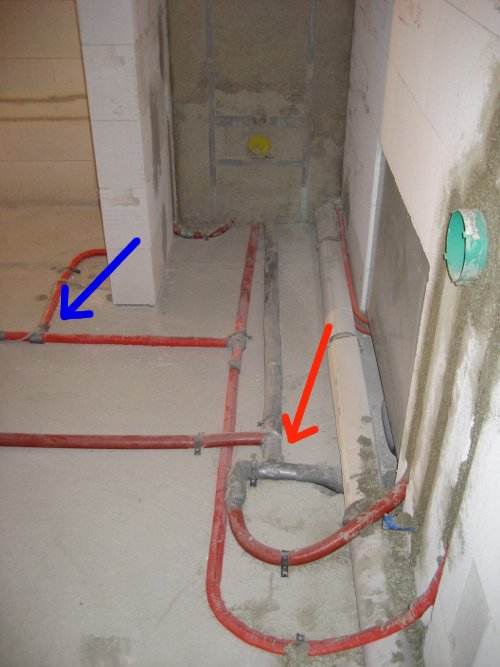 Take 26mm at least this far
Take 26mm at least this farAktiv supplied us with 16mm and 26mm plumbing piping. The standard sizes are 16, 20, 26 and 32mm. The inside diameter of the fittings for 16mm piping is about 7.5mm. Due to our laws of physics and the possible water requirements in a modern house a restriction of 7.5mm in your water supply lines can result in pressure differences between hot and cold water. Have you ever taken a nice warm shower and had someone flush the toilet next to you? Does the water temperature change? It can.
Since Aktiv Bausatzhaus Südbaden GmbH did not supply us with 20mm piping I took the 26mm piping as far as the last tee to all of our showers and bath tub. This will drastically reduce pressure differences that could occur in your plumbing.
I was concerned also about the recommendation in some manufacturers literature about the necessary supply line sizes for high volume shower and bath tub fixtures. If you follow my rule of thumb about the last tee, connecting to the fixture with a 16mm line should be in most cases, even if 20mm or 3/4 sizing is called for, okay.
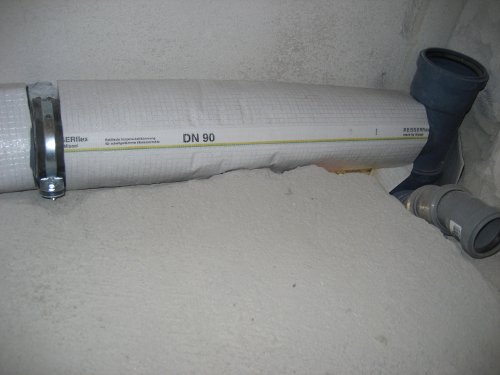 Long drain runs under Floor
Long drain runs under FloorDependent on your luck at planning bathrooms and drains you may have the problem we had of long runs with little slope possible. The standard answer is to box the pipe in and bring it above the finished floor height. This way you will have no problem to maintain a slope greater than 1%.
Well I don't like having corners boxed in. These things are just a pain for just too many reasons so what can you do with a finished floor thickness of 14-15cms?
In some other countries main drains from toilets are made with 90cm diameter piping. Here in Germany 110cm piping is used and that is what Aktiv Bausatzhaus Südbaden GmbH will supply you with. With only a 90cm pipe you have just saved 2cm of height.
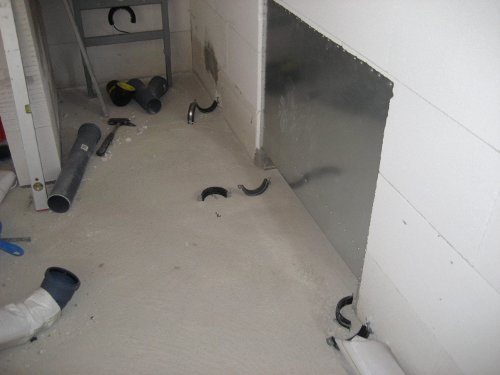 Made it to toilet and still under the floor height
Made it to toilet and still under the floor heightThe standard slope for plumbing pipes ranges from 1 to 2%. The length of run here was 4 meters resulting in an increase in height of 4cm or more. With the 90cm pipe the recommended slope can be reduced to 0.5% thereby saving another 2cm. With a little chiselling out of the floor underneath the last 2m of pipe the resulting height is about 10cm at the toilet and the pipe can be well hid underneath the floor.
Another tip is that although the small pipe transports solids better because of the increase depth of liquid you might as well want to increase the volume of water your toilet uses to flush. Thanks Micheal for the tips that have worked great so far.
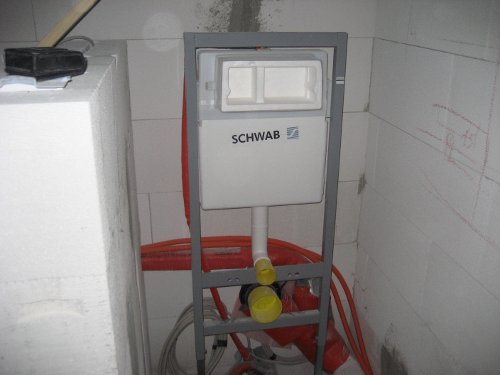 Not much choice!
Not much choice!Since I've been talking about toilets lets clear the air. The only manufacturer we were offered was Schwab. After they were installed our neighbor, that also built with Jogi, told us about his and soon to become our problem. The company Schwab offers very few options for the style and colors of the flush buttons. If you like classy, designer or elegant buttons/face-plates don't use the Schwab hardware, in my opinion. Luckily or perhaps because of this Aktiv Bausatzhaus GmbH's supplier now includes the much more known and used Geberit manufacturer.
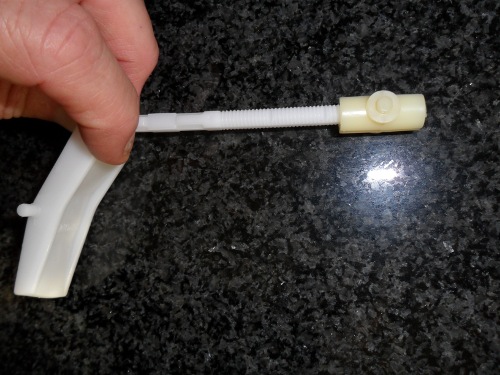 Schwab Lever System Jams
Schwab Lever System JamsWell I first thought that after 2 toilets I had just done something wrong. After very carefully and several times reading the assembly instructions, I put the third toilet into operation. After 3 weeks or so the same problem. The lever jams not letting a complete flush take place unless you press much harder. Then the joint snaps as it moves to a new angle. I have one more toilet to install some day and I was almost thinking about replacing the complete hardware even though it is completely plastered in place.
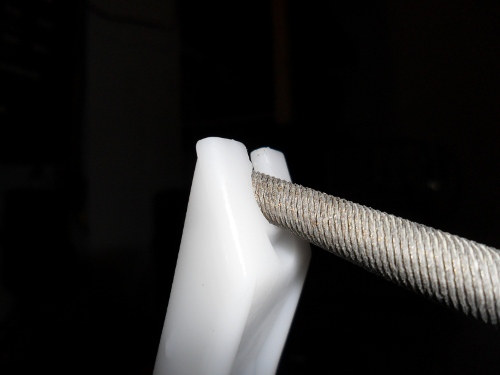 Solution for Lever
Solution for LeverOne day this problem came to the top of the priority list. After a rather close investigation I tried filing the lever so it could move more freely. This has curred our 3 toilets and saved the removal of the fourth.
If you look close directly under the file you can see a small lip in an area that looks a groove that would support more movement of the lever joint. File out about half or a little more of this lip. Don't take too much away. You don't want the pull-rod to fall down into the lever you just want it to be able to make a shorter angle. By adjusting the length of the pull-rod you should be able to keep the rod in place even if you do file too much away.
I am not sure if someone had planned this design to help in the two stage movement of the lever but it doesn't work. For the large or small flush the respective buttons of the face-plate move the lever respectively. We have had no problems since but next time I would still chose another manufacturer.
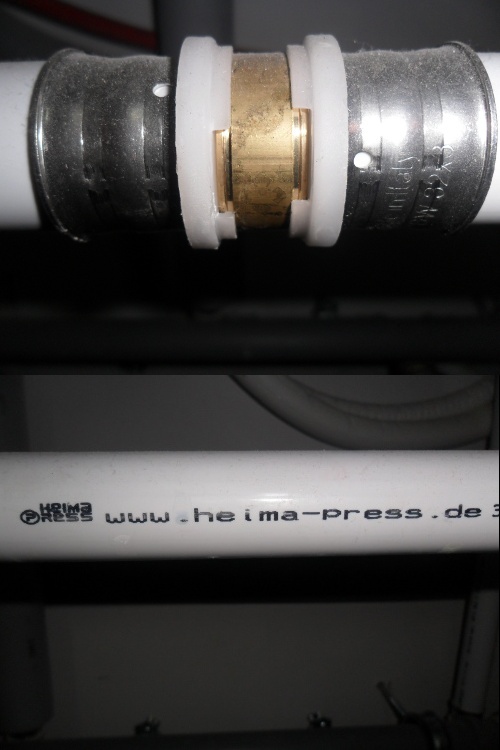 Conclusions
ConclusionsThis is the type of pipe and fittings Aktiv Bausatzhaus Südbaden GmbH provides you with. I found the material easy to work with. The manual crimping tool is useless in crowded spots but that is the same for most systems. Aktiv made the tools available when we needed them. This 2 o-ring system is fairly common and I am told by professional plumbers that it works good for them as well.
If you have been reading along you could likely understand my opinion that the guidance from Aktiv is less than could be desired. I did go looking for advice in other places and was able to find it.
If you take the time to pick your fixtures before roughing in your plumbing this could save some headaches. Some sinks and taps have other than standard locations of drains and supplies. Aktiv does not include under plaster mixing valves. Yes, there are, could be, advantages to having the valves outside of the wall but I like single handle shower controls much better. In this case you will need to know which manufacturer of controls you will use at the time of roughing in the plumbing.
I could not use the plans that Aktiv Bausatzhaus Südbaden GmbH produced for our plumbing because they did not fit the structural changes we had made to our house before the prefabricated floor slabs were produced. No circulation lines were included in our master bathroom and once we had the knowledge of how to run longer lines from our toilets without coming above the floor, we changed the arrangement completely anyways.